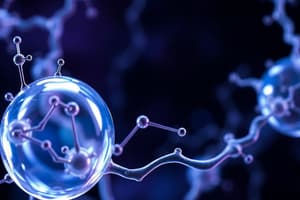Podcast
Questions and Answers
What is the primary role of ATP in cellular processes?
What is the primary role of ATP in cellular processes?
- Maintaining cell structure
- Regulating enzyme production
- Providing the energy required for various cellular activities (correct)
- Facilitating DNA replication
Besides ATP, which other molecule is also considered an 'energy-rich' compound?
Besides ATP, which other molecule is also considered an 'energy-rich' compound?
- FADH2
- GTP (correct)
- NADH
- Acetyl-CoA
In the context of catabolic processes, what is the initial breakdown product of carbohydrates?
In the context of catabolic processes, what is the initial breakdown product of carbohydrates?
- Acetyl CoA
- Amino acids
- Fatty acids
- Simple sugars (correct)
What is the primary characteristic of Stage 3 in catabolic processes?
What is the primary characteristic of Stage 3 in catabolic processes?
Under limited glucose availability, which molecules become more crucial for energy production?
Under limited glucose availability, which molecules become more crucial for energy production?
Where does glycolysis take place in the cell?
Where does glycolysis take place in the cell?
What is produced during glycolysis, in addition to a small amount of ATP?
What is produced during glycolysis, in addition to a small amount of ATP?
Which of the following is NOT a reaction type that occurs during glycolysis?
Which of the following is NOT a reaction type that occurs during glycolysis?
The first reactions of glycolysis, involving 6-carbon units, require energy. What is this stage commonly referred to as?
The first reactions of glycolysis, involving 6-carbon units, require energy. What is this stage commonly referred to as?
What is the net ATP production in glycolysis?
What is the net ATP production in glycolysis?
What is the end product of glycolysis?
What is the end product of glycolysis?
Where does the formation of acetyl coenzyme A from pyruvate take place?
Where does the formation of acetyl coenzyme A from pyruvate take place?
Under anaerobic conditions, what can pyruvate be converted into?
Under anaerobic conditions, what can pyruvate be converted into?
Why is the citric acid cycle also known as the Krebs cycle or the tricarboxylic acid cycle?
Why is the citric acid cycle also known as the Krebs cycle or the tricarboxylic acid cycle?
Where does the citric acid cycle occur in eukaryotic cells?
Where does the citric acid cycle occur in eukaryotic cells?
The citric acid cycle functions under which conditions?
The citric acid cycle functions under which conditions?
How many carbon atoms enter the citric acid cycle via acetyl CoA at the start of the process?
How many carbon atoms enter the citric acid cycle via acetyl CoA at the start of the process?
What role does the citric acid cycle play in biosynthesis?
What role does the citric acid cycle play in biosynthesis?
In the citric acid cycle, what happens to the two carbon atoms that enter the cycle?
In the citric acid cycle, what happens to the two carbon atoms that enter the cycle?
How many steps are involved in one complete turn of the citric acid cycle?
How many steps are involved in one complete turn of the citric acid cycle?
Which molecule is produced in the citric acid cycle at the location in the image?
Which molecule is produced in the citric acid cycle at the location in the image?
The energy yield generated by the citric acid cycle is primarily in what form?
The energy yield generated by the citric acid cycle is primarily in what form?
What is the overall stoichiometry of the citric acid cycle?
What is the overall stoichiometry of the citric acid cycle?
Why does the citric acid cycle only functions under aerobic conditions?
Why does the citric acid cycle only functions under aerobic conditions?
Which biosynthetic intermediate is derived from α-ketoglutarate?
Which biosynthetic intermediate is derived from α-ketoglutarate?
Which of the following is the correct summary of the end products of glycolysis?
Which of the following is the correct summary of the end products of glycolysis?
Which of the following is the correct summary of the end products of the Citric Acid Cycle?
Which of the following is the correct summary of the end products of the Citric Acid Cycle?
How many molecules of NADH are produced from each molecule of pyruvate that is converted to acetyl coenzyme A?
How many molecules of NADH are produced from each molecule of pyruvate that is converted to acetyl coenzyme A?
If a cell has plentiful ATP available, how might this affect the rate of glycolysis?
If a cell has plentiful ATP available, how might this affect the rate of glycolysis?
Flashcards
ATP (Adenosine Triphosphate)
ATP (Adenosine Triphosphate)
The universal energy molecule used in cells for various processes.
Catabolic Processes
Catabolic Processes
A series of metabolic processes that break down molecules to produce energy.
Catabolic Stage 1
Catabolic Stage 1
The initial stage of catabolism, no useful energy is generated.
Catabolic Stage 2
Catabolic Stage 2
Signup and view all the flashcards
Catabolic Stage 3
Catabolic Stage 3
Signup and view all the flashcards
Main Energy Source
Main Energy Source
Signup and view all the flashcards
Glycolysis
Glycolysis
Signup and view all the flashcards
Pyruvate
Pyruvate
Signup and view all the flashcards
Acetyl-CoA Formation
Acetyl-CoA Formation
Signup and view all the flashcards
Fermentation Fate
Fermentation Fate
Signup and view all the flashcards
Citric Acid Cycle
Citric Acid Cycle
Signup and view all the flashcards
Citric Acid Products
Citric Acid Products
Signup and view all the flashcards
Carbon atoms in Citric Cycle
Carbon atoms in Citric Cycle
Signup and view all the flashcards
Reaction Types in Glycolysis
Reaction Types in Glycolysis
Signup and view all the flashcards
Study Notes
Energy and Metabolism
- Energy is needed to move in the environment, build required molecules like DNA, proteins, and enzymes, transport nutrients, and balance Na/K levels.
- Everything cells do requires energy.
Adenosine Triphosphate (ATP)
- ATP is the universal energy molecule.
- ATP contains high-energy phosphate bonds.
- Energy-rich compounds include guanosine triphosphate (GTP), cytidine triphosphate (CTP), and uridine triphosphate (UTP).
Catabolic Processes Overview
- Stage 1 involves the breakdown of proteins into amino acids, carbohydrates into simple sugars, and fats into fatty acids.
- Stage 2 includes glycolysis and the conversion to pyruvate an acetyl CoA.
- Stage 3 is the citric acid cycle and oxidative phosphorylation.
- Stage 1 does not generate useful energy.
- Stage 2 generates a small amount of ATP.
- Stage 3 produces the majority of ATP.
- Stage 2 operates anaerobically (without oxygen), while Stage 3 is aerobic (with oxygen).
Energy Supply
- Most organisms get their main energy supply from metabolizing glucose and other sugars.
- Fat and protein metabolism becomes more important when glucose and other sugars are limited.
- Glycolysis is the initial stage in glucose metabolism.
Glycolysis
- Glycolysis occurs in stage two of the metabolic process and takes place in the cytoplasm.
- Glycolysis does not require oxygen and is not very efficient.
- The reaction produces two molecules of NADH (Nicotinamide Adenine Dinucleotide).
- Glycolysis comprises 10 different reactions using 10 different enzymes.
- Glycolysis can be divided into reactions with 6 carbon units that require energy (hexose stage) and reactions with 3 carbon units that provide energy (triose stage).
- Six different reaction types in glycolysis include phosphoryl transfer, phosphoryl shift, isomerisation, dehydration, aldol cleavage, and oxidation.
- Consumption and generation of ATP in glycolysis includes -1 ATP for glucose to glucose 6-phosphate, -1 ATP for fructose 6-phosphate to fructose 1,6-bisphosphate, +2 ATP for 2 x 1,3-Bisphosphoglycerate to 2 x 3- Phosphoglycerate, +2 ATP for 2 x Phosphoenol pyruvate to 2 x Pyruvate resulting in an overall +2 ATP.
Fate of Pyruvate
- The end product of glycolysis is pyruvate, which can be converted to acetyl coenzyme A, lactate, or ethanol.
- Acetyl coenzyme A formed from pyruvate is used in the citric acid cycle and the electron transport chain and is in the mitochondria.
Citric Acid Cycle
- The citric acid cycle which takes place in the mitochondria, is also known as the tricarboxylic acid cycle or Krebs' Cycle.
- The citric acid cycle is an aerobic stage that requires oxygen.
- Acetyl CoA enters the citric acid cycle, where it is fully oxidised to carbon dioxide and water.
- he citric acid cycle provides intermediates for biosynthesis.
- Two carbon atoms enter as acetyl CoA, add onto a four-carbon unit to give citric acid, and then leave as carbon dioxide.
- The citric acid cycle has nine steps and can be divided into parts involving 6-Carbon atoms, 5-Carbon atoms, and 4-Carbon atoms.
- The citric acid cycle does not directly produce many ATP molecules, instead it produces 3 molecules of NADH, 1 molecule of FADH2 (Flavin Adenine Dinucleotide), and 1 molecule of GTP, which are converted into ATP during the electron transport chain.
- GTP (guanosine triphosphate) is a high energy molecule.
- Overall stoichiometry involves Acetyl CoA + 3NAD+ + FAD + GDP + Pi + 2H2O becoming 2CO2 + 3NADH + FADH2 + GTP + 2H+ + CoA
- The regeneration of NAD+ and FAD requires molecular oxygen, so the citric acid cycle only works under aerobic conditions.
Summary of Glycolysis and Citric Acid Cycle
- Glycolysis involves converting glucose to 2 molecules of pyruvate, producing 2 ATP and 2 NADH.
- Pyruvate is converted to acetyl coenzyme A, producing 2 NADH per glucose.
- The Citric acid cycle converts acetyl CoA to CO2, producing 2 GTP, 6 NADH, and 2 FADH2.
Studying That Suits You
Use AI to generate personalized quizzes and flashcards to suit your learning preferences.




